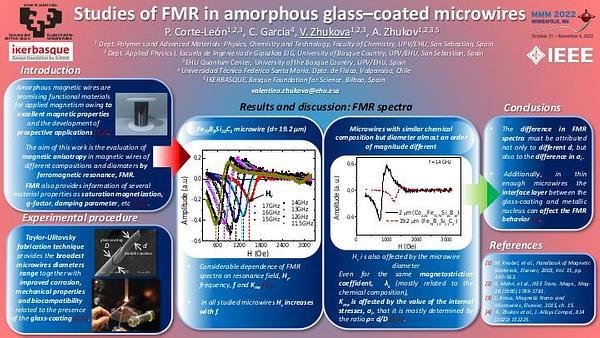Would you like to see your presentation here, made available to a global audience of researchers?
Add your own presentation or have us affordably record your next conference.
Rapidly solidified submicronic amorphous glass-coated wires have been extensively investigated recently due to their unique combination of reduced diameters (100 to 900 nm), very long sample length (10-2 to 103 m), and bistable magnetic behavior, suitable for both sensing and magnetic logic applications 1.
Here we report on the interaction between domain walls that propagate inside amorphous (Co0.94Fe0.06)72.5Si12.5B15 glass-coated submicronic wires with nearly zero magnetostriction (λ = -1 × 10-7).
The experimental set-up relies on six pick-up coils (C2 through C7) distributed evenly along the wire and two nucleation coils (C1 and C8) placed at its ends, the entire system being in a long magnetizing solenoid. If there is no signal in the nucleation coils, the sample magnetization reverses from one end (C1) to the other (C8), with only one propagating domain wall being detected successively by the pick-up coils: C2 → C3 → C4 → C5 → C6 → C7.
By applying synchronized rectangular nucleation signals in C1 and C8, magnetization reversal starts at both wire ends. Through the signal amplitudes, we adjusted the time interval between the generation of the two domain walls moving towards each other, and, in this way, the location on the wire axis where the two domain walls would collide. The collision results in a double amplitude peak within one of the pick-up coils, as compared to the peak that corresponds to a single domain wall passing through such a coil. By keeping the nucleation signal constant in C1 at 0.5 mA and varying the signal in C8 between 0.1 and 0.9 mA, one can relocate the domain wall interaction point in any pick-up coil. Fig. 1 shows the displacement of the collision point for an amorphous sample with 750 nm in diameter.
The results show that the interaction of domain walls in such small diameter cylindrical amorphous wires is fully controllable, which is vital for magnetic logic applications.
Work supported by the Romanian Executive Unit for Financing Higher Education, Research, Development and Innovation (UEFISCDI) through project PN-III-P4-ID-PCE-2020-1856 MaDWallS (contract PCE1/2021).
References:
1 S. Corodeanu, C. Hlenschi, C. Rotarescu, H. Chiriac, N. Lupu, T.-A. Óvári, J. Alloy. Compd., Vol. 905, 164260 (2022).

Fig. 1. Displacement of domain walls interaction point for an amorphous submicronic wire with 750 nm in diameter.
